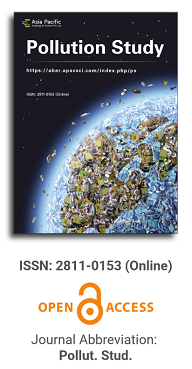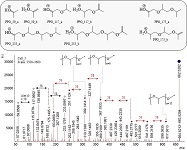
Asia Pacific Academy of Science Pte. Ltd. (APACSCI) specializes in international journal publishing. APACSCI adopts the open access publishing model and provides an important communication bridge for academic groups whose interest fields include engineering, technology, medicine, computer, mathematics, agriculture and forestry, and environment.

The (partial) replacement of synthetic polymers with bioplastics is due to increased production of conventional packaging plastics causing for severe environmental pollution with plastics waste. The bioplastics, however, represent complex mixtures of known and unknown (bio)polymers, fillers, plasticizers, stabilizers, flame retardant, pigments, antioxidants, hydrophobic polymers such as poly(lactic acid), polyethylene, polyesters, glycol, or poly(butylene succinate), and little is known of their chemical safety for both the environment and the human health. Polymerization reactions of bioplastics can produce no intentionally added chemicals to the bulk material, which could be toxic, as well. When polymers are used to food packing, then the latter chemicals could also migrate from the polymer to food. This fact compromises the safety for consumers, as well. The scarce data on chemical safety of bioplastics makes a gap in knowledge of their toxicity to humans and environment. Thus, development of exact analytical protocols for determining chemicals of bioplastics in environmental and food samples as well as packing polymers can only provide warrant for reliable conclusive evidence of their safety for both the human health and the environment. The task is compulsory according to legislation Directives valid to environmental protection, food control, and assessment of the risk to human health. The quantitative and structural determination of analytes is primary research task of analysis of polymers. The methods of mass spectrometry are fruitfully used for these purposes. Methodological development of exact analytical mass spectrometric tools for reliable structural analysis of bioplastics only guarantees their safety, efficacy, and quality to both humans and environment. This study, first, highlights innovative stochastic dynamics equations processing exactly mass spectrometric measurands and, thus, producing exact analyte quantification and 3D molecular and electronic structural analyses. There are determined synthetic polymers such as poly(ethylenglycol), poly(propylene glycol), and polyisoprene as well as biopolymers in bags for foodstuffs made from renewable cellulose and starch, and containing, in total within the 20,416–17,495 chemicals per sample of the composite biopolymers. Advantages of complementary employment in mass spectrometric methods and Fourier transform infrared spectroscopy is highlighted. The study utilizes ultra-high resolution electrospray ionization mass spectrometric and Fourier transform infrared spectroscopic data on biodegradable plastics bags for foodstuffs; high accuracy quantum chemical static methods, molecular dynamics; and chemometrics. There is achieved method performance |r| = 0.99981 determining poly(propylene glycol) in bag for foodstuff containing 20,416 species and using stochastic dynamics mass spectrometric formulas. The results highlight their great capability and applicability to the analytical science as well as relevance to both the fundamental research and to the industry.
Effect of the application of composted manure on the mobility of Cu chemical fractions in a soil contaminated with mining waste
Vol 4, Issue 1, 2023
Download PDF
Abstract
The weathering of mining wastes with a high content of metallic sulfides is involved in the release and mobility of heavy metals, being one of the main risk factors for the environment and public health. In this work, two types of manure were used to evaluate their effect on the mobile or bioavailable chemical fractions of Cu in a soil contaminated with mining waste. An experiment was conducted using a soil artificially contaminated with 25% mining waste from Zimapán, to which increasing doses of composted cow and pig manure (0, 3, 6, 12 and 24%) were added. The pseudo-total Cu concentration was determined by atomic absorption spectrophotometry after acid digestion, while the Cu chemical fractions were determined from sequential extractions. The results obtained showed a high pseudo-total Cu concentration in the mining residues and low in the soil and in both types of manure. In the treatments with greater application of pig manure, there was a decrease in the concentration of soluble-interchangeable Cu and an increase in the concentration of Cu strongly bound to the organic fraction. While with cow manure there were higher concentrations of soluble-interchangeable Cu and an increase in the fraction of Cu weakly bound to the organic fraction.
Keywords
References
- Higueras P, Oyarzun R. Mining and Environment Course Mining Environment (Spanish). Available online: https://previa.uclm.es/users/higueras/ mam/ (accessed on 19 May 2021).
- He ZL, Yang XE, Stoffella PJ. Trace elements in agroecosystems and impacts on the environment. Journal of Trace Elements in Medicine and Biology. 2005; 19(2-3): 125-140. doi: 10.1016/j.jtemb.2005.02.010
- Rieuwerts JS, Thornton I, Farago ME, et al. Factors influencing metal bioavailability in soils: preliminary investigations for the development of a critical loads approach for metals. Chemical Speciation & Bioavailability. 1998; 10(2): 61-75. doi: 10.3184/095422998782775835
- Davutluoglu OI, Seckin G, Ersu CB, et al. Heavy metal content and distribution in surface sediments of the Seyhan River, Turkey. Journal of Environmental Management. 2011; 92(9): 2250-2259. doi: 10.1016/j.jenvman.2011.04.013
- Zeien H, Bruemmer GW. Chemical extractions to identify heavy metal binding forms in soils. Mitteilungen der Deutschen Bodenkundlichen Gesellschaft. 1989; 59: 505-510.
- Ahumada I, Mendoza J, Navarrete E, et al. Sequential extraction of heavy metals in soils irrigated with wastewater. Communications in Soil Science and Plant Analysis. 1999; 30(9-10): 1507-1519. doi: 10.1080/00103629909370303
- Kim RY, Yoon JK, Kim TS, et al. Bioavailability of heavy metals in soils: definitions and practical implementation—a critical review. Environmental Geochemistry and Health. 2015; 37(6): 1041-1061. doi: 10.1007/s10653-015-9695-y
- Vega FA, Covelo EF, Andrade ML. Competitive sorption and desorption of heavy metals in mine soils: Influence of mine soil characteristics. Journal of Colloid and Interface Science. 2006; 298(2): 582-592. doi: 10.1016/j.jcis.2006.01.012
- Gleyzes C, Tellier S, Astruc M. Fractionation studies of trace elements in contaminated soils and sediments: a review of sequential extraction procedures. Trends in Analytical Chemistry. 2002; 21: 451-467. doi: 10.1016/S0165-9936(02)00603-9
- Clemente R, Bernal MP. Fractionation of heavy metals and distribution of organic carbon in two contaminated soils amended with humic acids. Chemosphere. 2006; 64: 1264-1273. doi: 10.1016/j. chemosphere.2005.12.058
- Farrell M, Perkins WT, Hobbs PJ, et al. Migration of heavy metals in soil as influenced by compost amendments. Environmental Pollution. 2010; 158(1): 55-64. doi: 10.1016/j.envpol.2009.08.027
- Campos T, Chaer G, Leles P dos S, et al. Leaching of Heavy Metals in Soils Conditioned with Biosolids from Sewage Sludge. Floresta e Ambiente. 2019; 26(spe1). doi: 10.1590/2179-8087.039918
- Sungur A, Soylak M, Yilmaz S, et al. Heavy metal mobility and potential availability in animal manure: using a sequential extraction procedure. Journal of Material Cycles and Waste Management. 2015; 18(3): 563-572. doi: 10.1007/s10163-015-0352-4
- Zhou T, Wu L, Luo Y, et al. Effects of organic matter fraction and compositional changes on distribution of cadmium and zinc in long-term polluted paddy soil. Environmental Pollution. 2018; 232: 514-522. doi: 10.1016/j.envpol.2017.09.081P
- Wiatrowska K, Komisarek J. Role of the light fraction of soil organic matter in trace elements binding. Plos One. 2019; 14(5): e0217077. doi: 10.1371/ journal. pone.0217077
- Palmer RG. Laboratory manual. Mexico: Libros y editoriales S.A. D. F.; 1979. p. 158.
- Nelson DW, Sommers LE. Total carbon and organic matter. In: Woodwell GM (editor). Methods of soil Analysis Part 3 Chemical Methods. Soil Science Society of America; 1982. pp. 961-1010.
- Gee GW, Bauder JW. Particle size analysis. In: Klute A (edotor). Methods of soil Analysis. Part 1. Physical and Mineralogical Methods, 2nd ed. Agronomy Monography 9. ASA and SSSA, Madison, WI; 1986. pp. 404-407.
- Rowell DL. Soil Science: Methods and Applications. Longman, Harlow; 1994.
- Pagnanelli F, Moscardini E, Giuliano V, et al. Sequential extraction of heavy metals in river sediments of an abandoned pyrite mining area: pollution detection and affinity series. Environmental Pollution. 2004; 132(2): 189-201. doi: 10.1016/j.envpol.2004.05.002
- Hund-Rinke K, Koerdel W. Underlying issues in bioaccessibility and bioavailability: Ex-perimental methods. Ecotoxicology and Environ-mental Safety. 2003; 56: 52-62.
- Sparks DL. Environmental soil chemistry, 2nd ed. San Diego: Academic; 2002.
- Alloway BJ. Trevors JT. Heavy metals in soils: Trace metals and metalloids in soils and their bioavailability. Dordrecht, Springer; 2013. 613p.
- Caporale AG, Violante A. Chemical Processes Affecting the Mobility of Heavy Metals and Metalloids in Soil Environments. Current Pollution Reports. 2015; 2(1): 15-27. doi: 10.1007/s40726-015-0024-y
- Shi W, Lü C, He J, et al. Nature differences of humic acids fractions induced by extracted sequence as explanatory factors for binding characteristics of heavy metals. Ecotoxicology and Environmental Safety. 2018; 154: 59-68. doi: 10.1016/j.ecoenv.2018.02.013
- USEPA. Soil Screening Guidance. Technical Background. Document. U.S. Gov. Print. Office; 1996.
- Tembo BD, Sichilongo K, Cernak J. Distribution of copper, lead, cadmium and zinc concentrations in soils around Kabwe town in Zambia. Chemosphere. 2006; 63(3): 497-501. doi: 10.1016/j.chemosphere.2005.08.002
- Duarte VM, Carrillo-González R, Lozano ML, et al. Fractionation of heavy metals in mine tailings amended with composted manure. Soil and Sediment Contamination: An International Journal. 2019; 28(2): 148-161. doi: 10.1080/15320383.2018.1553931
- Usman ARA, Kuzyakov Y, Stahr K. Effect of Immobilizing Substances and Salinity on Heavy Metals Availability to Wheat Grown on Sewage Sludge-Contaminated Soil. Soil and Sediment Contamination: An International Journal. 2005; 14(4): 329-344. doi: 10.1080/15320380590954051
- Abollino O, Aceto M, Malandrino M, et al. Distribution and mobility of metals in contaminated sites. Chemometric Investigation of Pollutant Profiles. Environmental Pollution. 2002;119: 177-193. doi: 10.1016/s0269-7491(01)00333-57
- Hayes, Bloomfield C. The translocation of metals in soils. In: The Chemistry of Soil Processes. John Wiley & Sons Ltd; 1981.
- Concas A, Montinaro S, Pisu M, et al. Mechanochemical remediation of heavy metals contaminated soils: Modelling and experiments. Chemical Engineering Science. 2007; 62(18-20): 5186-5192. doi: 10.1016/j.ces.2007.02.024
- Jiang M, Zeng G, Zhang C. Assessment of heavy metal contamination in the surrounding soils and surface sediments in Xiawangang River, Qingshuitang District. Plos One. 2013; 8(8): e71176. doi: 10.1371/journal. pone.0071176
Supporting Agencies
Copyright (c) 2023 Mayumi Noemí Mendoza-Jiménez, Rosa Isela Quintero-Soriano, Victor Manuel Duarte Zaragoza, Violeta Carrasco-Hernández
License URL: http://creativecommons.org/licenses/by/4.0/

This site is licensed under a Creative Commons Attribution 4.0 International License (CC BY 4.0).
.jpg)
Beijing University of Technology, China



